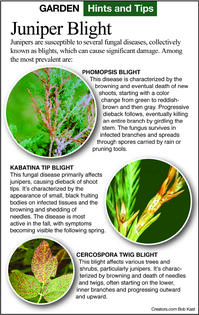The Greener View: Juniper Tip Blight
Q: I have a significant amount of blue rug junipers in my landscape. Every spring, there is a large amount of twig blight that I have to trim. I have been doing this for over 20 years, and it is getting old. Is there a fungicide I can use to address this condition?
A: I have always liked blue rug juniper. It has a nice color and only grows 6-12 inches high but can spread 6-12 feet wide. It grows equally well in the South and North and in many soil types. It was originally found on an island off the coast of Maine in 1914, so it has been in the nursery trade for a long time. Like most junipers, it is susceptible to tip blight. But tip blight is not just one thing, so we have to do some detective work to know what kind of tip blight we are dealing with.
Juniper needles and branches can die for many reasons. Overwatering, voles eating the bark in the winter, salt spray from the ocean or nearby highways can kill evergreen needles; problems that can kill small evergreen twigs include branches being walked on, dry spells can that cause dieback, root injury, damage from string trimmers or lawn mowers, spider mites and various insects.
And then there are the diseases. These infect not only junipers, but also arborvitae, cedars, Douglas fir, larch and some pines.
Phomopsis tip blight, sometimes referred to as juniper twig blight, is the most common. It infects young needles in the spring and then enters the stem, causing the last few inches of the branch to die first, and then the whole branch may die later. The needles turn rusty red and then gray. The fungus spreads with splashing water, insects and wind when the temperature is in the 70s and the humidity is high. Irrigation water and rain at night are bad. The fungus can live in the dead stems for years and reinfect the plant during that time.
At first, Kabatina tip blight symptoms look like Phomopsis, but there are key differences. It infects the plant in the fall, not spring. Therefore, it is found on older branches, not the new growth in the spring. The dying needle and branch symptoms often occur in late winter or very early spring, long before new growth will be showing symptoms from Phomopsis. Kabatina infected branches rarely have extensive dieback.
Cercospora twig blight needle dying symptoms are found on the oldest needles and branches first, instead of the newest branches. It starts on the lowest branches or the innermost branches and spreads outward. The dieback is on needles, not branches.
If you were just starting out, I would tell you to look for newer evergreen varieties that are more resistant to these diseases. Also, don't plant junipers in too much shade or near driveways that get salted during the winter, don't plant them in soil that stays wet and don't use overhead irrigation at night.
You are using the correct control method of pruning out the dead branches. You need to do this when the plants are dry, since moving the dead branches around may spread the spores. You should cut the branches back 1-2 inches into the live area, past the line between the dead and green needles. You should dip the pruner in rubbing alcohol between cuts so you don't spread the disease during pruning. This can be very tedious if there are lots of branches to prune. Don't compost the dead branches or use them for mulch. They must be burned or disposed of. Don't do any pruning during the wet seasons of spring and fall, since pruning wounds expose the plant to new fungal infections at the wounds caused by pruning.
I don't usually tell people names or brands of products for several reasons. The product may not be available in their area due to regulations, and I don't want them to break the law. Other products that would work just fine might be available while they are looking for the one I mentioned. The cost may be better for the other product. Products occasionally change formulations, so the product I recommend may not work or be appropriate anymore. Newer products may be safer or more effective than an old product that I recommend or that the person sees in an article years after it was first published.
Anyway, you should be able to find a fungicide for use on junipers for tip blight diseases in your local garden center. If you think the problem is more likely to be Kabatina, then apply the fungicide this fall. Select a fungicide labeled for use on junipers containing mancozeb, thiophanate-methyl or copper fungicides. Apply all chemicals according to directions on the label.
========
Email questions to Jeff Rugg at info@greenerview.com. To find out more about Jeff Rugg and read features by other Creators Syndicate writers and cartoonists, visit the Creators Syndicate website at www.creators.com.
Copyright 2025 Jeff Rugg. Distributed By Creators.








Comments